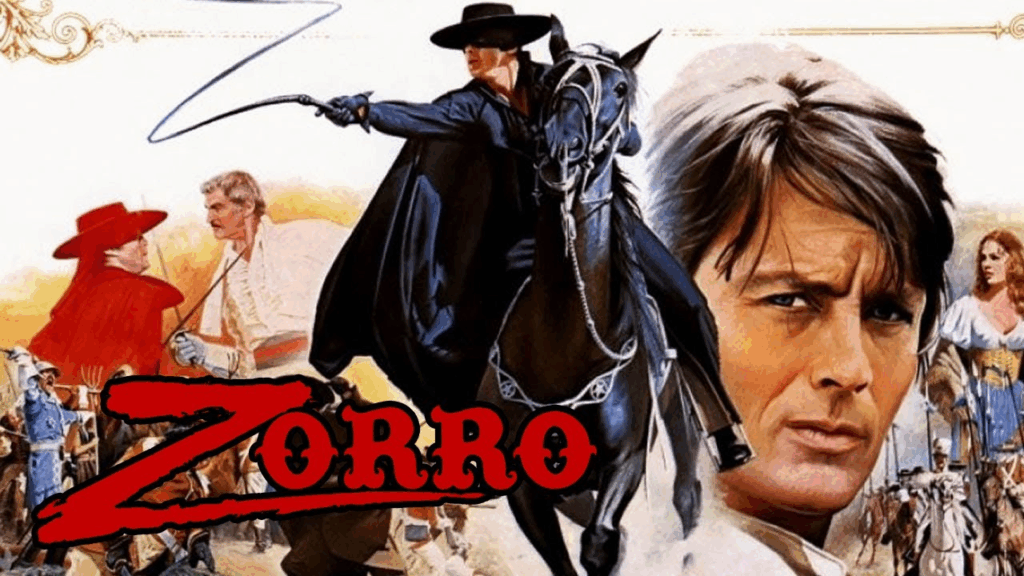“Zorro”, 1998

The Mask of Zorro (1998): A Swashbuckling Revival of a Legend
Released on July 17, 1998, The Mask of Zorro is a vibrant American Western swashbuckler that reintroduced the iconic masked vigilante Zorro to a new generation. Directed by Martin Campbell and produced by Steven Spielberg’s Amblin Entertainment for TriStar Pictures, the film blends high-energy action, romance, and humor with a timeless tale of justice and vengeance. Starring Anthony Hopkins as the aging Don Diego de la Vega, Antonio Banderas as his spirited successor Alejandro Murrieta, and Catherine Zeta-Jones as the fiery Elena, The Mask of Zorro revitalized the Zorro legacy, earning critical acclaim and commercial success with a global box office of $250.3 million against a $95 million budget. This comprehensive article delves into the film’s background, plot, cast, themes, production, reception, and lasting impact, celebrating its status as one of the finest swashbucklers of the 1990s.
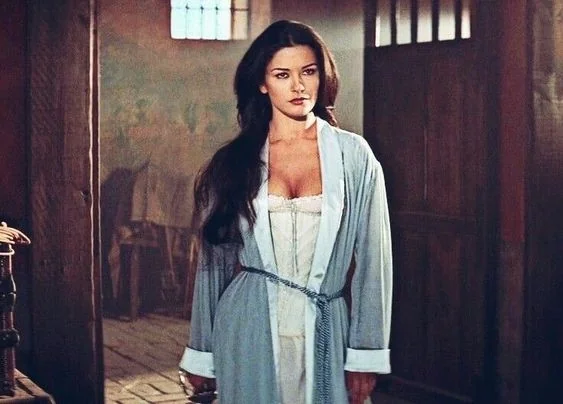
Background and Origins
Created by Johnston McCulley in 1919 for the serialized story “The Curse of Capistrano,” Zorro—Spanish for “fox”—is a masked swordsman who defends the oppressed in Spanish-controlled California. Inspired by figures like Joaquin Murrieta and literary predecessors like the Scarlet Pimpernel, Zorro became a cultural icon through silent films starring Douglas Fairbanks (The Mark of Zorro, 1920), Tyrone Power’s 1940 remake, and Disney’s 1957–59 TV series with Guy Williams. By the 1990s, Zorro’s cinematic presence had waned, prompting Spielberg to develop a modern take for TriStar Pictures.
Initially, directors Mikael Salomon and Robert Rodriguez were attached, with Salomon casting Sean Connery as Don Diego de la Vega and Rodriguez bringing in Antonio Banderas as the new Zorro. When Connery dropped out and Campbell signed on in 1996, Anthony Hopkins replaced Connery, and the project gained momentum. Campbell, fresh off directing GoldenEye (1995), brought a knack for polished action, while writers John Eskow, Ted Elliott, and Terry Rossio crafted a script blending historical context with swashbuckling flair. The film incorporates real figures like Joaquin Murrieta, fictionalized as Alejandro’s brother, and sets its story during the Mexican War of Independence’s aftermath, though it takes liberties with historical timelines.
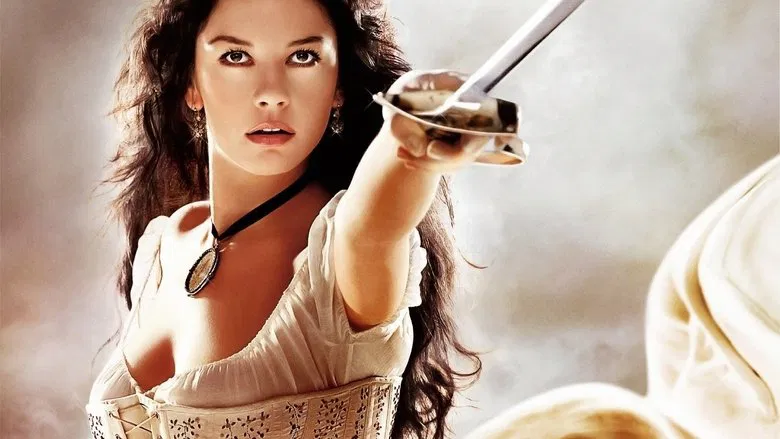
Plot Summary
Set in 1821, The Mask of Zorro opens with Don Diego de la Vega (Anthony Hopkins), the legendary Zorro, fighting Spanish oppression in Alta California. During a daring rescue at a public execution, Zorro thwarts corrupt governor Don Rafael Montero (Stuart Wilson), earning the admiration of two young brothers, Alejandro and Joaquin Murrieta. Montero, suspecting Diego’s identity, raids his home, accidentally killing Diego’s wife Esperanza, imprisoning Diego, and stealing his infant daughter, Elena. Twenty years later, in 1841, Montero returns from Spain with the now-grown Elena (Catherine Zeta-Jones), plotting to exploit California’s gold.
Diego escapes prison and encounters Alejandro Murrieta (Antonio Banderas), a troubled bandit mourning his brother Joaquin’s death at the hands of Montero’s henchman, Captain Harrison Love (Matt Letscher). Recognizing potential in Alejandro, Diego trains him to become the new Zorro, teaching swordsmanship, horsemanship, and charm. As Alejandro infiltrates Montero’s circle, posing as a nobleman, he falls for Elena, unaware she’s Diego’s daughter. The duo uncovers Montero’s scheme to buy California from General Santa Anna using gold mined by enslaved peasants. Through daring swordfights, horseback chases, and a climactic battle in a gold mine, Diego and Alejandro confront Montero and Love, seeking vengeance and justice. The film ends with Alejandro embracing the Zorro mantle, Diego’s legacy secured, and a new romance blossoming.

Cast and Characters
The Mask of Zorro boasts a stellar cast whose chemistry elevates its swashbuckling spirit:
- Anthony Hopkins as Don Diego de la Vega/Zorro: Hopkins brings gravitas and pathos to the aging Zorro, a nobleman turned vigilante seeking to reclaim his daughter and avenge his wife. His mentorship of Alejandro blends stern authority with wry humor.
- Antonio Banderas as Alejandro Murrieta/Zorro: Banderas shines as the roguish yet charming Alejandro, transforming from a drunken bandit to a heroic Zorro. His charisma and physicality make him a perfect successor.
- Catherine Zeta-Jones as Elena: Zeta-Jones delivers a breakout performance as Elena, Montero’s spirited ward and Diego’s daughter. Her fiery chemistry with Banderas, especially in a sensual swordfight and dance scene, is a highlight.
- Stuart Wilson as Don Rafael Montero: Wilson portrays the cunning, hissable governor with cold menace, a worthy foe for both Zorros.
- Matt Letscher as Captain Harrison Love: Letscher’s cruel, obsessive captain, who preserves Joaquin’s head in a jar, adds a gruesome edge, though some critics found him less threatening than intended.
Supporting roles, including Tony Amendola as a priest and L.Q. Jones as a bandit, add depth to the vibrant ensemble.
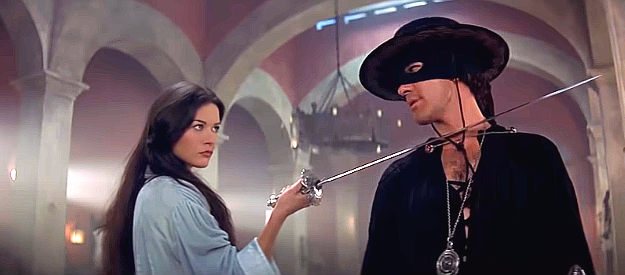
Themes and Style
The Mask of Zorro weaves timeless themes into its action-packed narrative:
- Justice vs. Vengeance: The film explores the moral ambiguity of revenge, as Diego and Alejandro’s personal vendettas fuel their fight against Montero’s oppression. It questions when justice becomes vigilantism.
- Legacy and Mentorship: The passing of the Zorro mantle from Diego to Alejandro symbolizes generational continuity, with Diego’s training shaping Alejandro’s heroism.
- Economic Injustice: Zorro’s defense of enslaved miners reflects his Robin Hood-like crusade against exploitation, rooted in McCulley’s original vision.
- Honor and Identity: Zorro’s dual identity as a nobleman and masked hero underscores a code of honor, with Alejandro learning to embody charm and courage.
Stylistically, the film is a love letter to classic swashbucklers like those of Errol Flynn, featuring dynamic swordfights, horseback chases, and practical stunts that feel refreshingly analog compared to modern CGI spectacles. James Horner’s Spanish-tinged score, with its rousing themes and tango flourishes, enhances the romantic and adventurous tone. The cinematography, capturing Mexico’s haciendas and deserts, evokes Western grandeur, while the pacing balances action, romance, and humor. At 136 minutes, some critics noted its length, but the explosive finale and spirited performances keep it engaging.
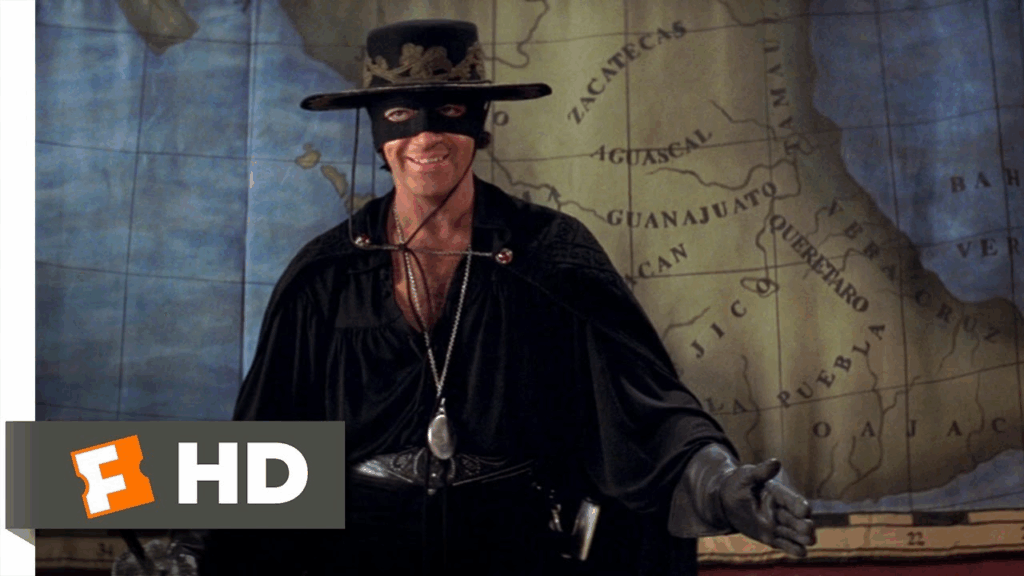
Production and Release
Produced by Amblin Entertainment and TriStar Pictures, The Mask of Zorro began filming in January 1997 at Estudios Churubusco in Mexico City, leveraging authentic locations to recreate 19th-century California. Campbell’s direction emphasized practical effects, with stunt coordinators crafting intricate swordfights and horseback sequences. The $95 million budget supported lavish sets, costumes, and a robust marketing campaign, including a $1.3 million Super Bowl XXXII ad and a trailer attached to Godzilla prints.
The film was initially set for December 19, 1997, but moved to March 1998 to avoid clashing with Titanic, eventually landing on July 17, 1998, in 2,515 theaters. Its premiere drew European royalty, including Spain’s King Juan Carlos I, and a Royal Command Performance for Prince Charles, underscoring its global appeal. Sony’s innovative online marketing, using VRML for the official website, marked an early embrace of digital promotion. The film was released on VHS and DVD on December 1, 1998, Blu-ray on December 1, 2009, and 4K UHD on May 5, 2020.

Reception and Cultural Impact
The Mask of Zorro was a critical and commercial triumph, grossing $94 million domestically and $156.2 million internationally for a $250.3 million total. On Rotten Tomatoes, it holds an 84% approval rating from 77 reviews, with critics praising its “nimble, entertaining” swashbuckling and strong cast. Roger Ebert gave it three stars, lauding its “sense of honor” and integration of stunts with story, calling it “probably the best Zorro movie ever made”. Richard Schickel of Time hailed its tribute to classic Hollywood, while audiences gave it an “A−” CinemaScore. Some critiques noted its length and casting choices, with Mick LaSalle questioning Hopkins’ British accent in a Mexican setting.
The film earned nominations for two Academy Awards (Best Sound and Best Sound Effects Editing) and two Golden Globes (Best Motion Picture – Musical or Comedy and Best Actor for Banderas). It launched Zeta-Jones to stardom and solidified Banderas as a Hollywood leading man. Its success spawned a sequel, The Legend of Zorro (2005), also directed by Campbell with Banderas and Zeta-Jones, though it received mixed reviews and underperformed.
Culturally, The Mask of Zorro revitalized interest in Zorro, inspiring future adaptations, including planned reboots like Zorro Reborn and a Django/Zorro crossover. Its practical stunts and romantic flair remain a benchmark for swashbucklers, with fans on platforms like Letterboxd calling it a “timeless classic” and “bisexual anthem” for its sizzling Banderas-Zeta-Jones chemistry. The film’s economic justice themes and Latinx hero resonate with modern audiences, cementing Zorro’s enduring appeal.
Where to Watch
As of May 24, 2025, The Mask of Zorro is available to stream on Netflix and Amazon Prime Video (for rent or purchase). Physical copies on Blu-ray, DVD, and 4K UHD are available via retailers like Amazon. Check JustWatch for current availability.
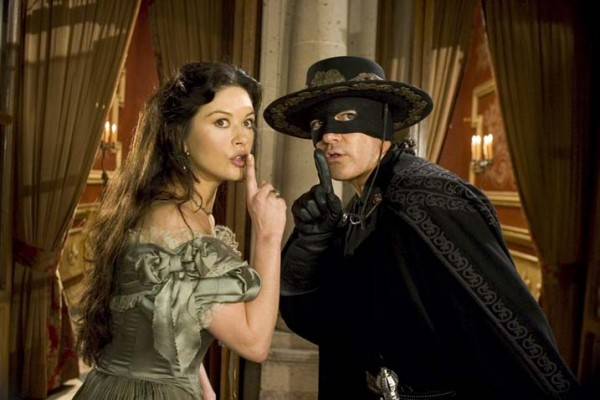
Conclusion
The Mask of Zorro (1998) is a triumphant revival of a legendary hero, blending heart-pounding action, heartfelt romance, and sharp humor into a swashbuckling masterpiece. With Anthony Hopkins’ dignified mentorship, Antonio Banderas’ magnetic heroism, and Catherine Zeta-Jones’ radiant presence, the film honors Zorro’s legacy while forging a new path. Martin Campbell’s assured direction, coupled with a rich script and practical stunts, delivers a timeless adventure that stands among the best Zorro adaptations. Its critical and commercial success, cultural impact, and continued relevance make it a must-watch for fans of classic Hollywood storytelling and modern action alike. Whether carving a “Z” with his sword or stealing hearts, Zorro’s 1998 outing remains an unforgettable cinematic gem.
